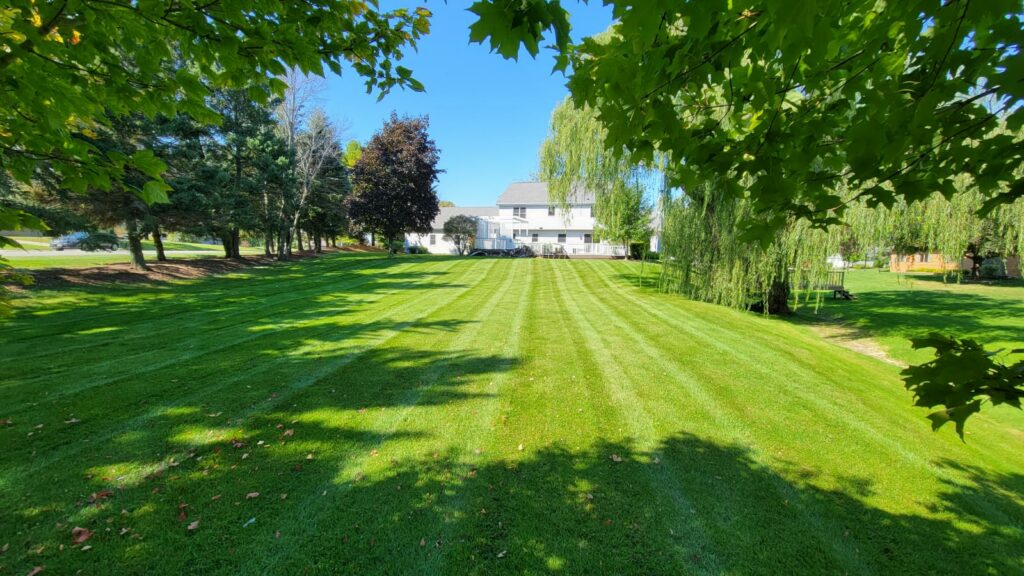
Thank you for choosing Landmark Landscapes as your turfgrass specialist. Your new lawn has been installed to the highest standards and is in accordance with all industry standards and applicable state and local laws, ordinances, rules and regulations. Right about now, as you look out at an expanse of brown soil, you may be thinking: “Oh my, what have I done?” Rest assured your lawn will spring to life, and in just a few short weeks you will be looking out at a carpet of green. Follow the simple guidelines, as explained below, and you are sure to have a lawn that is the envy of the neighborhood. If you ever have any questions please contact your Account Manager or call our office at (920) 467-6442.
Watering
It is important to give a newly seeded lawn immediate and constant attention. A temporary irrigation system should be installed on the lawn for the critical weeks following the turf seed installation. If Landmark Landscapes has set up the irrigation, it is on a timer and is set to turn on 2-3 times per day. It is a good idea to check on the seeded area at least once a day, especially if there is abundant sun, wind or high temperatures, and provide supplemental water to any areas that look dry. Watering is the most important aspect of seed germination; if the seedlings are not constantly moist they will die. Spray from the sprinklers should be gentle.

Keep checking to be sure the upper 1/4-1/2 inch of soil is constantly moist. If soil becomes dry and starts to crack, increased watering is necessary. Hand sprinkle any dry spots that may have occurred (especially common on windy days). Keep the surface moist until seedlings are up: typically 4-6 weeks or longer, depending on seed varieties. Avoid puddling, which dislodges seed and causes washouts. If the soil becomes dry too many times in a row, the percent of viable seed/success rate drops dramatically.
The watering program has to change once seeds have germinated. After the grass is up and its roots are down, the intervals between waterings should be farther apart. When the seedlings are 1-2 inches high, irrigate once a day, depending on weather. Allow the surface to dry between watering. Fungal diseases can kill seedlings under high moisture conditions, especially when paired with warm temperatures. Never apply irrigation when night temperatures are estimated to be above 70 degrees Fahrenheit and avoid late evening watering.

After establishment, increase the length of watering time for greater soil moisture depth. This will encourage the turf to form a deeper root system. Continue to water in droughty summer months.
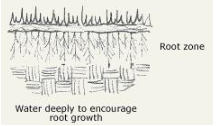
Weeds & Grass Coverage
Weeds do not come from the seed mixtures but from the soil. Weed seeds often lie dormant for a long time, and germinate when they find conditions favorable to growing: Soil that has been turned over and exposure to water and light.
Do not spray with a broadleaf weed killer until after the fourth mowing because it will injure the young turf. Many kinds of weeds such as velvet leaf and lambsquarters are common and will be eliminated once mowing begins and later with chemical control. If annual grasses such as foxtail, crabgrass, and barnyardgrass germinate with your new seeding, wait until the following spring to apply a pre-emergent product. Pre-emergent products prevent the germination of new seedlings. Take this into consideration if you plan to spot seed areas.
Broadleaf weed control is much more effective if applied in the fall. Do not apply herbicides in spring, especially on newly seeded lawns.
It takes about two years to develop a tight, satisfactory lawn. Generally, in the first year, coverage is about 50 percent. The grass consists of single, straight stalks. The second year has about 90 percent coverage. The bluegrass rhizomes fill in and form a solid, dense turf if proper care has been given. If there are areas of your lawn that have the seed washed away from heavy rain or irrigation use the seed that Landmark Landscapes has left you to sprinkle on the bare areas. Rake the seeds into the bare soil with a rake to ensure good seed to soil contact.
Mowing
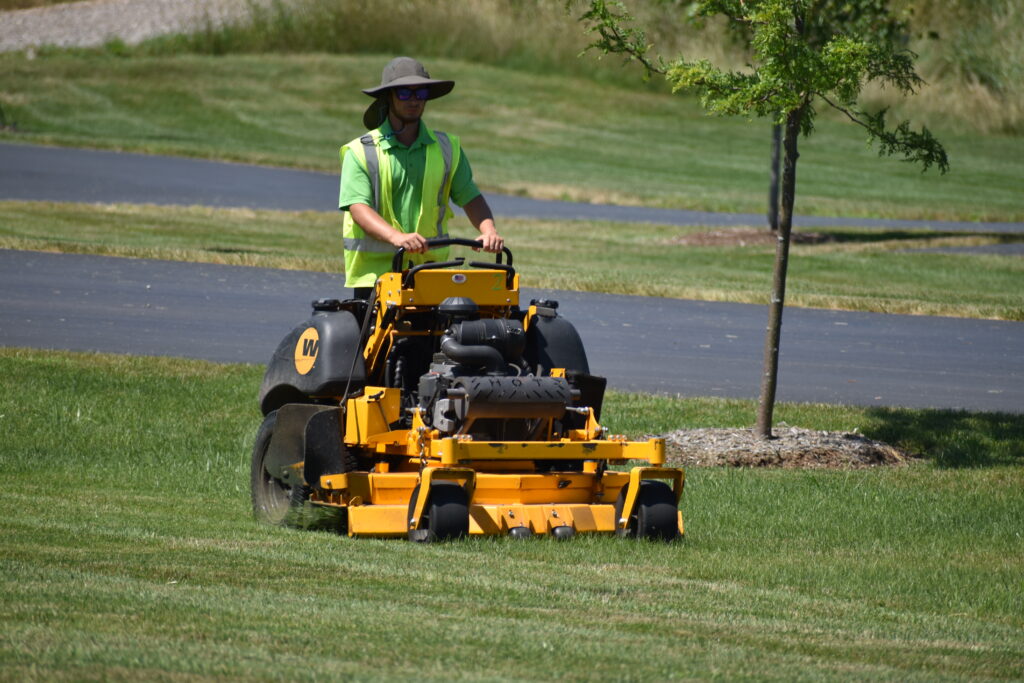
Do not allow the grass to get much longer than the height at which it will be maintained. Kentucky Bluegrass and Red Fescue should be mowed at a 3 inch height. Mow when the soil is firm and dry and the grass well rooted. Mowing on wet soil will pull out seedlings and cause ruts. Never cut more than a 1/3 of the grass blade at one time. A sharp blade on your mower is always beneficial to your turf. Care should be taken not to leave a mat of grass clippings on the new turf. Mulching mowers work well, or rake off mats of grass clippings to avoid smothering tender new turf.
Mowing turf short in late fall is not recommended, the turf is using the limited sunlight to store carbs as it prepares to go into dormancy. It’s important to remove any organic debris (leaves, sticks) from your turf canopy before snowfall. This prevents providing an extra food source for rodents under the long winter blanket and helps prevent fungal diseases from growing.
Fertilizing
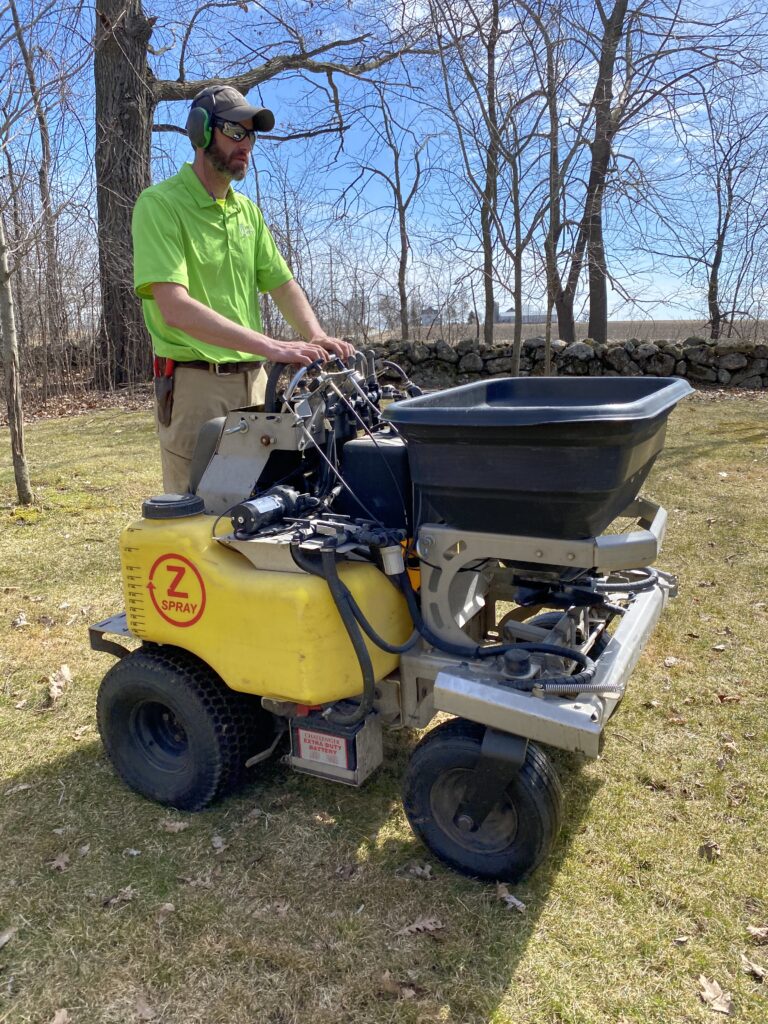
At the time of seeding, the lawn was given an application of starter fertilizer. After the first mowing or two, you can apply a complete (N-P-K) fertilizer. Use an organic fertilizer or slow-release chemical fertilizer. A young lawn can be easily burned and should not be treated with a quick-release fertilizer.
A simple fertilizer schedule to follow is called the “Holiday Schedule”. The first application should be made on or around Memorial Day. The second application should be made on Independence Day. The third application follows on Labor Day, the last application should be made around Halloween or after the last mowing of the season.
A yearly fertilizer program on an established lawn includes 3 to 4 pounds of actual nitrogen per 1000 square feet, which is applied in several spring and fall applications. Nitrogen (N) is the nutrient needed in the largest quantities, followed by potassium (K) and phosphorus (P). Avoid fertilizing an unirrigated lawn in the heat of the summer. A slow release fertilizer will reduce danger of fertilizer burn and over stimulation of top growth.
Fall fertilizer applications are the most important. Feeding at this time helps the grass make use of this season of ideal sunlight, moisture, and temperature. This is when turf grasses are growing most actively, strengthening their roots, and tillering to develop new plants, which will fill in weak areas of the lawn. Lawns such as these are more resistant to all pests. According to University of Wisconsin research and our experience, fall feeding is essential.
Late Fall Fertilization
New shoot growth has stopped at this time of the year but the grasses’ roots are storing up food reserves. Fertilizer applied now provides the energy for grass to survive Wisconsin’s harsh winter conditions and recuperate in spring with a healthy, gradual green-up.
Erosion Mats
Do not remove any straw matting used to prevent erosion that was applied during seeding. All erosion mats used by Landmark Landscapes will break down naturally. Depending on the degree of erosion expected, erosion mats may be used to stabilize the soil. They are designed to break down after enough time has passed to allow the grass seed to become established and therefore stabilize the slope. Removing the erosion mats before seed is established will remove a significant percentage of the seedlings.
Traffic & Use
The roots of immature grass are easily harmed by heavy usage, even during the winter months. Keep vehicular, foot and even pet traffic off the lawn as much as possible during the first few months of growth.
Disease & Insect Problems
Diseases and insect problems are hard to diagnose and advice should be sought from an expert. Do not apply chemicals haphazardly before the problem is identified.
There are two conditions that can lead to or contribute to lawn problems and diseases. One is over-fertilization. Do not add more fertilizer than the recommended rate, especially in hot, humid weather or in early spring. Over-fertilizing promotes excessive, fast, top growth and may accentuate disease development.
The second is too much thatch. Thatch is the matting of undecomposed dead stems, leaves and roots in a layer just above the soil surface and below the green, vegetative growth. It is not grass clippings. Too much thatch keeps water from penetrating the soil and the root zone. Roots tend to grow into the thatch rather than deeply into the soil. Insects and diseases can easily establish themselves in the thatch layer.
Aeration
Thatch layers 1/2 inch or more thick should be aerated to begin to break down this excessive thatch layer. Aeration by machine removes cores of thatch and soil. These plugs of soil deposited on the turf surface contain bacteria that begin to break down the thatch layer. Core aeration also opens up hardened, impenetrable soil and allows water, air and fertilizer to reach the grass roots. Once your lawn is established you should plan on aerating your lawn once a year.
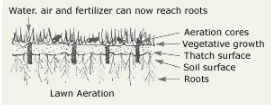
Landmark Turf Services
Please consider us your partner in the long term maintenance of this landscape investment. In addition to answering any questions that may arise, we also offer comprehensive landscape maintenance and construction services. We offer full turf management services, including: mowing, trimming, aerating, fertilizing and herbicide application. Landmark Landscapes also carries all of the products you need to keep your lawn beautiful should you want to purchase them and install them yourself. If you have any questions or would like to schedule a meeting with our turf care specialist, or just a single application of herbicide or fertilizer, please contact your Account Manager, or call the office: 920-467-6442.